The Sun and the 8 official planets of our solar system (Mercury, Venus, Earth, Mars, Jupiter, Saturn, Uranus and Neptune) are all unique in their orbit, color, size, mass and even composition.
Here we will try to transpose the size of the planets to human scale so that you can really appreciate the dimensions of these stars.
Here’s a table summarizing the size of the various planets on a human scale, as well as their distance from the Sun, listed in order of distance from the Sun. We’ve converted the distances to meters so you can get a better idea of the immensity of space and our galaxy.
| Planet | Human scale size | Distance from the Sun (on our scale) |
|---|---|---|
| Sun | 110 cm | / |
| Mercury | 0.4 cm | 45 m |
| Venus | 0.9 cm | 85 m |
| Earth | 1 cm | 117 m |
| Mars | 0.7 cm | 176 m |
| Jupiter | 11.2 cm | 611 m |
| Saturn | 9 cm | 1 129 m |
| Uranus | 4.1 cm | 2 258 m |
| Neptune | 3.9 cm | 3 539 m |
Le Soleil
The actual size of the Sun
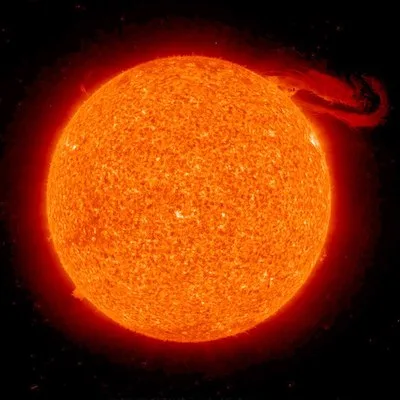
The Sun on a human scale

Features
| Composition | Mostly hydrogen and a little helium |
| Temperature | 6000°C and 15 million degrees Celsius at its core |
Our journey through the solar system begins here!
The star in our solar system is classified as a small to medium-sized star , measuring 1,329,000 km in diameter and weighing about 2 trillion tons. That’s not a typo, it’s really heavy! Its mass is 333,000 times the weight of Earth.
However, there are stars in the Universe that are much… MUCH more massive. For example, consider the star UY SCUTI located in our Milky Way, a star whose mass is 1,700 times greater than that of our Sun.
The surface of the Sun reaches a temperature of 6,000 degrees Celsius, but its core is 15 million degrees Celsius. Enough to make a nice barbecue.
Here are some interesting facts about our star:
- The Sun accounts for 99.8% of the mass of our solar system.
- If we put all the planets in the solar system together, the Sun would still be 50 times larger.
- The Earth could fit 12,000 times inside the Sun.
Now imagine the sun as a balloon 1.1 meters in diameter and let’s continue our journey through the solar system!
Mercury
Mercury is the smallest planet in our solar system with a diameter of 4879 kilometers, roughly the size of our moon.
If the Sun were a balloon 1.1 meters in diameter… Then Mercury would be the size… of a 0.5 cm pea!
The actual size of Mercury
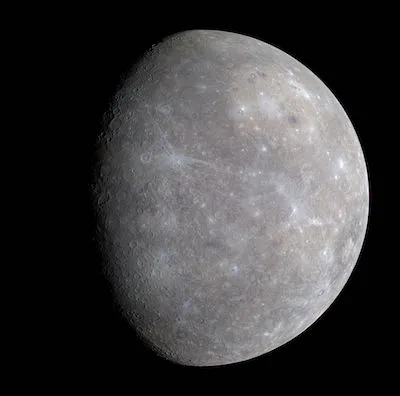
Mercury on a human scale
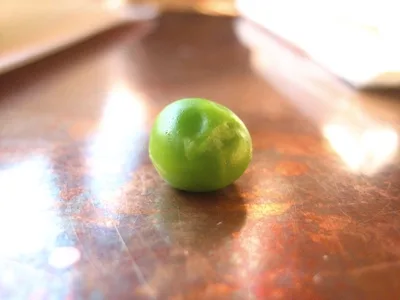
Features
| A Year on Mercury | 88 Earth days |
| One Day on Mercury | 59 Earth days |
| Temperature | 430°C during the day and -100°C at night |
Mercury is the closest planet to our star, at a distance of 57.9 million kilometers. Mercury is about 38% the size of Earth. It also has a mass of 3.285 × 10^23 kg, making it 18 times lighter than Earth.
A day on this planet lasts 59 Earth days, and its orbit lasts 88 Earth days. Mercury is made of iron and silica rocks. This planet also contains more iron in its core than any other planet in our solar system and has a gray appearance.
Here are some interesting facts about Mercury:
- It has no atmosphere and is a planet rich in volcanoes.
- Its orbital speed is 76 km/s.
- It therefore rotates very slowly on its axis. In fact, for every two orbits around the Sun, Mercury rotates three times on its axis.
- Mercury is the second densest planet in our solar system.
Venus
If the Sun were a balloon 1.1 meters in diameter… Then Venus would be a cherry.
The actual size of Venus
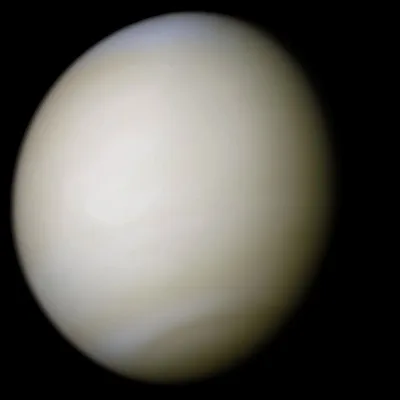
Venus on a human scale

Features
| A Year on Venus | 225 Earth days |
| One Day on Venus | 243 Earth days |
| Temperature | 450°C during the day and -140°C at night |
Venus is the second closest planet to the Sun and is named after the Roman goddess of love. Venus is 108.2 million km from the Sun and has a diameter of 12,104 kilometers, making it the closest planet to Earth in terms of size. It weighs 48.70 × 10 23 kg, or 0.815 of Earth’s mass, and contains a lot of greenhouse gases.
It takes Venus 225 Earth days to orbit the Sun. One day on this planet is equal to 243 Earth days. This means that one day on Venus is longer than one year !
Its temperature exceeds 450°C during the day, making it the hottest planet in our solar system.
Here are some interesting facts about this planet:
- Due to its similar morphology, Venus is often considered Earth’s sister.
- It has no rings or natural satellites.
- Probes cannot land on Venus because of its dense cloud of sulfuric gases.
- This planet rotates clockwise , while all other planets rotate counterclockwise.
- It has a very weak magnetic field
Earth
If the Sun were a balloon 1.1 meters in diameter… Then the Earth would be comparable to a cherry one centimeter in size.
The actual size of the Earth

The Earth on a human scale

Features
| A Year on Earth | 365 days |
| One Day on Earth | 24 hours |
| Temperature | the average temperature on Earth is 15°C |
Earth is the third most distant planet from the Sun and the only one that supports life. Due to its rotational axis, we have four seasons. The Moon, responsible for the tides, is our only natural satellite.
The Earth has a diameter of 12,756 kilometers and is 149.6 million km from the Sun. It has a mass of 5.972 × 10^24 kg and is approximately 4.6 billion years old.
Our planet is the densest planet in our solar system, and our atmosphere is composed of 78% nitrogen, 21% oxygen, 0.93% argon, and 0.03% carbon dioxide.
Here are some fun facts about our planet:
- The Earth’s rotation is gradually slowing down, so that in 140 million years the length of a day will decrease to 25 hours .
- It is tilted about 23 degrees on its axis of rotation.
Mars
If the Sun were a balloon 1.1 meters in diameter… Then Mars would be comparable to a
pea.
The actual size of Mars
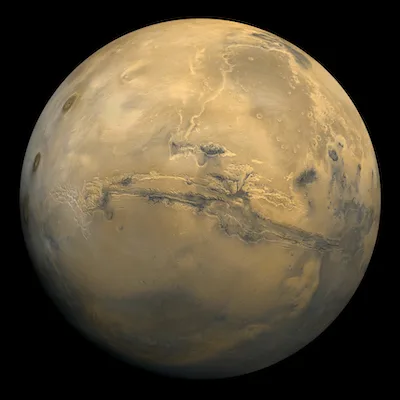
Mars on a human scale

Features
| A Year on Mars | 687 Earth days |
| One Day on Mars | 25 Earth hours |
| Temperature | 30°C during the day and -140°C at night |
Mars is the fourth most distant planet from our star and has an orange appearance. It is also the last of the terrestrial planets. Its gravity is one-third that of Earth, but it would be sufficient to sustain human life. A day on Mars lasts 25 hours, and Mars’s orbit around the Sun takes 687 Earth days. Mars weighs 6.418 5 × 10 23 kg and has a diameter of 6,779 kilometers, or 53% of the size of Earth . It is 227.9 million km from the Sun.
Interesting facts about Mars:
- The average speed of Mars’ orbit is 23 km/s.
- It is the second smallest planet in the solar system.
- It is a relatively cold planet, with an average temperature of -60 degrees Celsius
Here’s an extremely well-made video summarizing the different sizes of the planets in the solar system. The stars are listed in order of diameter.
Let’s go beyond the asteroid belt and discover the 5th planet of the Solar System together!
Jupiter
If the Sun were a balloon 1.1 meters in diameter… Then Jupiter would be the size of a grapefruit !
The actual size of Jupiter
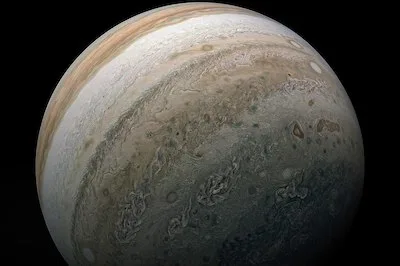
Jupiter on a human scale

Features
| A year on Jupiter | 12 Earth years |
| One day on Jupiter | 9 hours Earth time |
| Temperature | 110°C during the day and -110°C at night |
Jupiter is the largest planet in the solar system and the first of the gas giants. Jupiter is 778.3 million km from the Sun and has a diameter of 142,800 kilometers, more than 11 times the diameter of Earth. Jupiter has a mass of 1.898 × 10^27 kg and is 73 times larger than Earth.
On Jupiter, a day lasts only 9 hours, while an orbit around the Sun lasts 12 Earth years. Yes, it spins extremely fast!
It’s a gaseous planet, which means there’s no real soil to speak of. In reality, you have to think of this planet as a big ball of atmosphere.
Here are some interesting facts about Jupiter:
- It is large enough to encompass all the other planets combined.
- It is home to a permanent hurricane, the Great Red Spot, and is so large that Earth could fit inside twice.
- Jupiter’s Great Red Spot could disappear within 2100 years. The good news is that you still have 70 years to observe Jupiter and its Red Spot through a telescope !
- Jupiter protects Earth from asteroids
- The planet is composed of helium and hydrogen
- Scientists still do not know whether the core of this giant planet is solid or gaseous.
Saturn
If the Sun were a balloon 1.1 meters in diameter… Then Saturn would be the size of an orange !
The actual size of Saturn
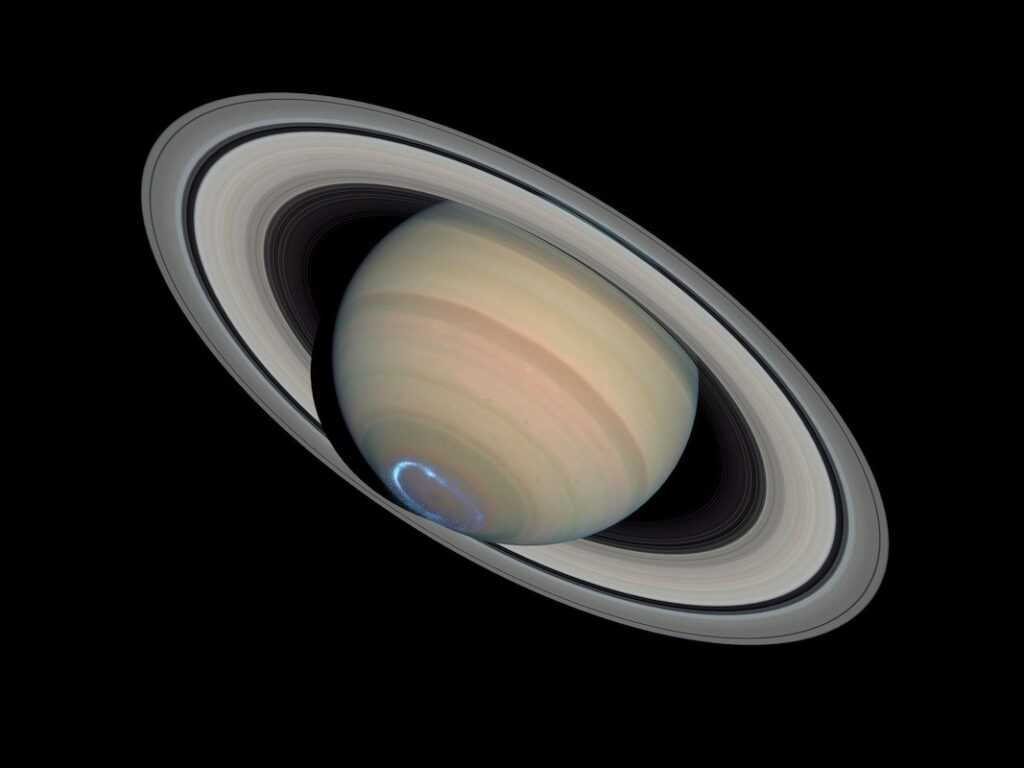
Saturn on a human scale

Features
| A Year on Saturn | 29.5 Earth years |
| One Day on Saturn | 10 Earth hours |
| Temperature | -180°C day and night |
Saturn is the second largest planet in our solar system with a diameter of 120,660 kilometers and a mass of 5.683 × 10^26 kg, or 95 times the weight of Earth.
It is located at a distance of 1,427 million km from the Sun and has a large ring composed of space debris and ice . An interesting fact: and that the thickness of Saturn’s rings in relation to its size is equal to a razor blade! To simplify: they are extremely thin…
It completes one revolution around the Sun in 29.5 Earth years, and one day on Saturn is equivalent to 10 hours on Earth.
Some fun facts about this planet:
- It is the most distant planet from the Sun that can be seen with the naked eye. It is also the most beautiful star to observe with a telescope or astronomical telescope !
- Saturn is composed of hydrogen, methane and helium .
- It has 82 satellites and more than 30 rings.
- The average temperature on its surface is -139 degrees Celsius.
Uranus
If the Sun were a balloon 1.1 meters in diameter… Then Uranus would be the size of a peach !
The actual size of Uranus
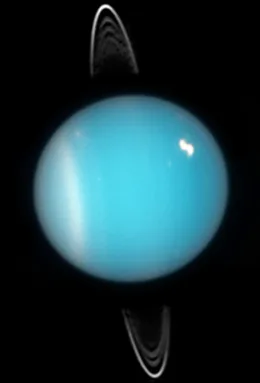
Uranus on a human scale

Features
| A Year on Uranus | 84 Earth years |
| One day on Uranus | 16 Earth hours |
| Temperature | -221°C day and night |
Uranus is the 7th most distant planet in our solar system and one of the most unique . Indeed, due to a -supposed- collision with another planet, its rotation axis is strongly tilted , which places its equator at a right angle to its orbit. Uranus has a tilt of 98 degrees!
Uranus’s core is also thought to be icy and rocky rather than molten like other planets. This unusual planet is 2,871 million km from the Sun, has a diameter of 51,000 km, and a mass of 8.681 × 10^25 kg (about 15 times the mass of Earth).
Here is some additional interesting information about Uranus:
- It is the third largest planet and the fourth largest planet
- It is one of the least dense planets in our solar system.
Finally, it completes a full rotation of the Sun in 84 Earth years and rotates on its axis in 18 Earth hours.
Neptune
If the Sun were a balloon 1.1 meters in diameter… Then Neptune would be the size of a peach !
The actual size of Neptune
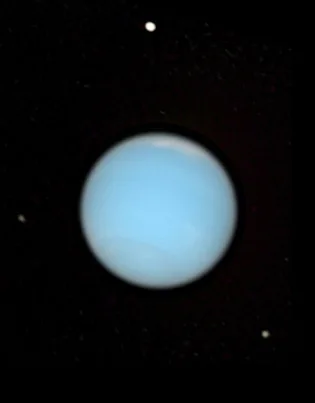
Neptune on a human scale

Features
| A Year on Neptune | 165 Earth years |
| One Day on Neptune | 18 Earth hours |
| Temperature | -230°C day and night |
Neptune is the farthest planet from the Sun, at 4,497 million km.
It has a diameter of 49,500 kilometers and a mass of 1.024 × 10^26 kg (17 times the mass of Earth). It is composed of hydrogen and helium and is surrounded by a cloud layer with winds faster than the speed of sound (2,100 km per hour).
An abundance of methane gives this planet a brilliant blue color. It orbits our star in about 165 Earth years, and a day on Neptune lasts 19 Earth hours.
Some interesting facts about Neptune:
- Officially discovered in 1846, it was the first planet discovered through mathematical calculations before being discovered through observation.
- It has 14 satellites and a thin set of rings.
- The fourth largest planet in the solar system, it is the coldest planet in the solar system with average temperatures of -200 degrees Celsius.
Pluton
You might be expecting to see Pluto in this article?
Please note that Pluto has not been considered a planet by the International Astronomical Union since 2006.
If you want to recreate the atmosphere of our solar system in your living room, take a look at our selection of planetarium projectors.
